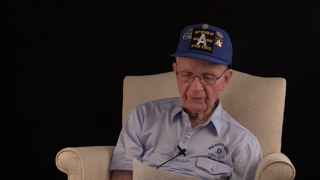7:15 | Returning from a mission, B-17 bombardier Dequindre McGlaun saw 2 planes from his flight collide right in front of him. The tumbling planes just missed his own aircraft. On another mission, the squadron flew on to Algiers and slept under the wing of their plane, "Shackaroo," for a week in the desert, waiting to return.
Keywords : Dequindre McGlaun B-17 Schweinfurt England Regensburg Danube North Africa Curtis LeMay Algiers Brenner Pass Shackeroo

Dequindre McGlaun was in bombardier training when Pearl Harbor was attacked. It was going well until he got sick and had to be held back and graduate with a later class. He was finally flying in B-17's when his crew was split up and he became an unassigned crew member.
The man at the pilot physical said that Dequindre McGlaun had eyes like a horse with outstanding peripheral vision. That didn't help when he was washed out by an overzealous captain. He went back to work in a civilian job but he contacted the Army Air Corps and offered himself up for bombardier training.
His crew had been split up and B-17 bombardier Dequindre McGlaun was waiting for an assignment. He was sent to the 94th Bomb Group, but when he was grounded with ear problems, his pilot was killed in a crash landing. Once again, he was a wandering bombardier without a crew.
Dequindre McGlaun volunteered for combat by taking the place of a bombardier who got cold feet. He didn't have to go but he was trained for it and he was tired of beating around the States, waiting for assignments. They got new B-17's to fly to England but, immediately, a problem developed.
The B-17 crews had crossed the Atlantic and were organizing in England. On his second mission, bombardier Dequindre McGlaun's plane was shot up so bad it had to be replaced. He told his mates that they had to get their attitude straight if they were going to deal with things like that and still be successful. After six missions, he was named lead bombardier.
B-17 bombardier Dequindre McGlaun recalls several of his bombing missions over Northern Europe. There were other bombers that nearly hit his and there were people on the ground who wanted to kill him. He changed planes and crews when he was made lead bombardier and he describes the nose art on the new plane.
The mission to Kiel was a fateful one for B-17 bombardier Dequindre McGlaun. The group was disorganized because of a base reassignment and the men were awakened at 3 AM with no advance notice of a mission. After hitting the target, his squadron was swarmed by enemy fighters. Every 50 cal machine gun on the plane was firing as the bomber slipped lower and lower toward the water.
B-17 bombardier Dequindre McGlaun discusses the change of command in his squadron and how the new commander wanted to get out of headquarters and fly. The bombardier describes the anti-aircraft flashes on the ground as German gunners took aim. "You better get me quick because I am going to get you!"
After a shuttle mission to North Africa, Dequindre McGlaun's B-17 squadron returned to it's base in England. Led by his plane, "Shackaroo," they hit a German submarine base on the way. Several highly successful missions followed, including a strike in the heart of Paris and one across the Baltic Sea that resulted in a classic photograph of the bomb run that wound up in museums.
As his tour wound down, B-17 bombardier Dequindre McGlaun was honored to have his commanding officers flying with him. At that point in the war, the German V-1 program was still secret but the Allied bombers were already hitting their bases. Time off in London was always welcome and he tells what he found there.
It had been quite a tour and B-17 bombardier Dequindre McGlaun returned to the States, got married and was assigned to teach new bombardiers in Texas. When VJ Day came, the town went nuts and, soon, he was out of the service and beginning a long and rewarding career as a teacher.
B-17 bombardier Dequindre McGlaun was inspired by his leaders in the 94th bomb group, including Frederick Castle, who was awarded the Medal Of Honor posthumously for guiding his crashing bomber away from American troops at the Battle of the Bulge. Ira Eaker and Curtis LeMay also were important commanding officers in his career